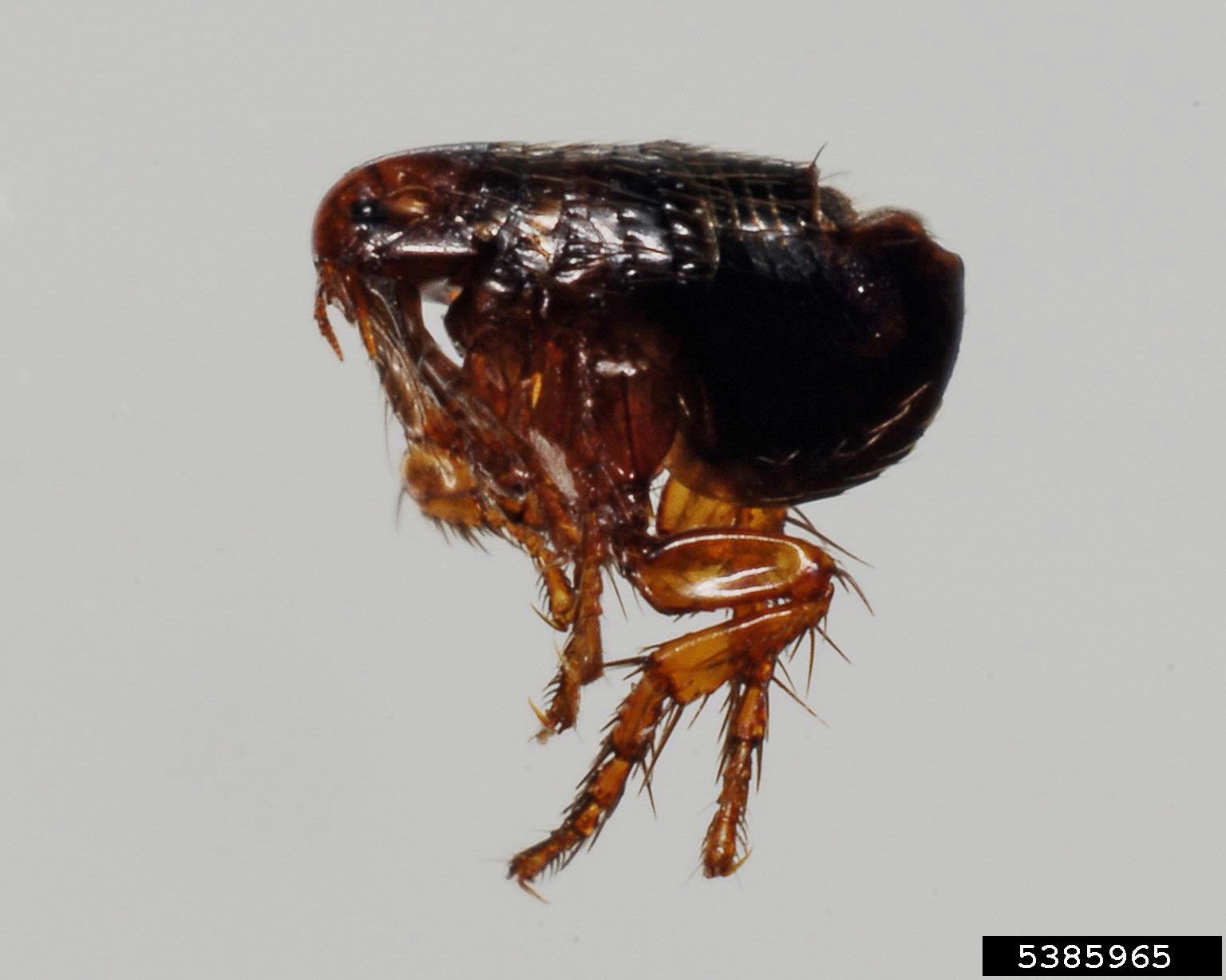 Managing Fleas - July 25, 2018 Jeff Schalau, Agent, Agriculture & Natural Resources University of Arizona Cooperative Extension, Yavapai County While fleas are not normally a serious problem in north central Arizona, their populations can build up where conditions are favorable. Pets, primarily dogs and cats, are often the hosts of fleas. Once detected, you should always use an integrated pest management (IPM) approach to reduce the population – just as you should when faced with weeds, insects, diseases, and vertebrates. While I have covered IPM many times in this column, it never hurts to review the four steps: 1) correct identification of pest; 2) monitor for damage (or nuisance) threshold; 3) once the threshold is reached, apply multiple prevention and control measures; and 4) monitor for effectiveness and revise strategy if needed. Flea problems usually begin with adult fleas feeding on your pet(s). The cat flea (Ctenocephalides felis) is the most common species and is commonly found on cats and dogs. After feeding and mating, a female cat flea can average 30 eggs per day. These eggs fall off the pet and develop off the animal. During an infestation, about 95% of the fleas are eggs, larvae, and pupae scattered throughout the house. The other 5% are adults living on the pet. Treatment strategies should concentrate on killing or removing/killing adult fleas on pets and preventing the immature stages from developing into adults. The most direct monitoring method is the flea comb. This is a specially designed comb having tines spaced close enough together to extract adult fleas. Cats and dogs tend to act as flea magnets. Comb the pet daily during flea season (summer). Count and remove the fleas from the flea comb and drop them in soapy water (they will sink and die). If you do not have pets, your flea problem may be caused by wildlife or rodents. Here you can monitor by wearing oversized white socks and walking through the area. Flea traps are also available which use light to attract the fleas. In addition to identification, these monitoring methods will provide data as to whether your control efforts are reducing the flea population. Various control methods are available and each has its advantages and disadvantages. Some factors that should be considered are: the degree to which the area is infested; whether your pet is indoors only, outdoors only, or a combination of the two; whether or not you are comfortable with chemical controls; and the amount of money and/or time you can invest. Simple physical controls include the flea comb and vacuuming or steam cleaning carpets. Flea traps are also available, but these are designed primarily for monitoring. Vacuuming is actually very effective and will remove adult fleas, most of the eggs, and some of the pupae and larvae. It also removes flea feces which is a food source for flea larvae. Effectiveness depends on carpet pile depth and strength of the vacuum. Remember to also vacuum couches and chairs, cushions and crevices, especially if pets have been resting there. A non-chemical IPM program could consist of daily flea combing (during flea season), vacuuming, and weekly washing of pet bedding. An additional step would be to monitor flea populations in rooms where pets spend the most time. When conditions warrant, pesticides can be used to add a greater degree of flea control. Pesticides that control adult fleas are often neurotoxins such as permethrin, fipronil, imidicloprid, and selamectin. These are often used to control fleas outdoors. Pesticides that control immature stages are less toxic to pets and humans because they target specific biochemical pathways and prevent the larvae from maturing into reproductive adults. These products are called insect growth regulators (IGRs) and many contain the active ingredient methoprene. Flea collars have been available for a long time and they can be effective when used in conjunction with non-chemical IPM strategies. Tablets can also be used to eliminate fleas on the host animal within 4-6 hours. Since 1995, spot-on formulas have been developed and revolutionized flea control technology. Spot-on products are applied directly to the pet and can be effective for up to three months. Depending on the product chosen, spot-on treatments can be enough to control a flea problem within the house. There are different products for cats and dogs, so read the package carefully. When considering specific flea treatments, pet owners should discuss the advantages and disadvantages with their veterinarian. Follow the Backyard Gardener on Twitter – use the link on the BYG website. If you have other gardening questions, call the Master Gardener help line in the Camp Verde office at 928-554-8992 or e-mail us at verdevalleymg@gmail.com and be sure to include your name, address and phone number. Find past Backyard Gardener columns or provide feedback at the Backyard Gardener web site: http://cals.arizona.edu/yavapai/anr/hort/byg/. Photos  Adult cat flea (Ctenocephalides felis, photo by Joseph Berger, Bugwood.org).
Adult cat flea (Ctenocephalides felis, photo by Joseph Berger, Bugwood.org).Additional Resources Integrated Flea Control Nebraska Extension in Lancaster County lancaster.unl.edu/pest/resources/integratedflea.shtml Safer Flea Control Texas A & M Agrilife Extension citybugs.tamu.edu/factsheets/biting-stinging/others/ent-3001/ |